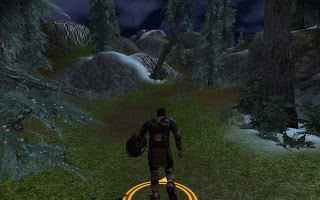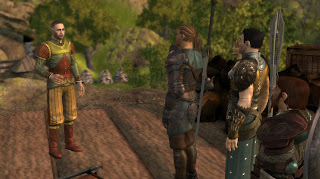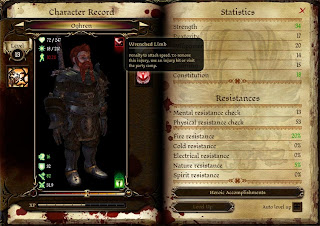A continuing trend across many games genres is a tendency towards every combat encounter within a game being its own discrete entity, and with no real continuity in terms of resource management across these encounters. Okay, I used big words there that make this sound more confusing than it actually is, but I'm trying to be specific. But let's quickly make it simple and take the example of a first person shooter...
This has resource management continuity
Health was a finite resource in Doom. You started off with 100 health, and every bit of damage you took subtracted from that total, but you could restore health (and even exceed your starting "maximum") by picking up items. If you did badly on a particular section or particular group of enemies, you began desperately searching for medkits to get your health back up to a safer level.
Jump forward to modern titles like Modern Warfare, Gears of War, Mass Effect or Uncharted 2, and you don't have a health number. When you get injured, your screen goes red (to varying degrees) indicating you've taken damage and need to bunker down to recover. When you finish one encounter, you're effectively at full health again and ready for whatever might come your way.
Dragon Age attempts to introduce a small middle ground, by penalising characters who fall in battle with "injuries" that hinder their performance in combat until the player uses an "injury kit" or returns to camp to heal. But for the most part, these injuries don't make a big difference upon a character's ability in combat. Maybe people who play on nightmare difficult might notice a more significant penalty, but I never really noticed any appreciable difference in fighting prowess as a result of injuries.
So a party member is injured. Do I really care?
Each system has it's own strengths and weaknesses, so let's take a look at them. For Doom, it's possible for one bad encounter to turn the tide for the entire level. A player gets through the first few fights and finds them really difficult and so has very low health as a result. The remaining fights in the level might be significantly easier, but the player can't get past them because they can't avoid being hit entirely, and they simply don't have the health to survive. This is bound to lead to frustration for the player, as they might try dozens of times to get past the level before realising they'll had to load up an earlier save (providing they actually have one) to do the first bit of the level again. It's generally considered poor design to get the player into a situation where they can't win, and that's effectively what this kind of system does.
On the flip side, this kind of system actually makes the player care about each individual combat scenario more. They know they have a limited amount of resources/health available to them, and hence will be more invested in every encounter with the enemy, because they know it will have an impact as they progress through the level. Some could argue that ammunition provides a degree of resource management for a game, but unless the designers are being unfathomably stingy with ammunition, this isn't really much of an argument. I'd also contend that if as a designer you're being that stingy with ammunition, you're probably making a game that many players are not going to find fun.
We don't play First Person Shooters to go ammo hunting
Now let's look the game without resource management. As a designer, it is easier to make every encounter more balanced and achievable for the player, because you know exactly how durable they are coming into the fight. You know they will have full health and how much damage they can take before dying. There's no need to consider the effects of previous encounters within the level on their current state, and thus it's easier to precisely manage the difficulty curve for the player. This is great in terms of pacing, as it allows the designer to do things like giving the player some easy encounters to make them feel good about themselves before throwing them in the deep end by putting them in a really tight spot. It's easier to provide a balanced game experience, and reduces the possibility of players getting stuck in a situation in which they can't possibly prevail.
However, the main weakness of the system stems from the lack of continuity, in that each individual combat scenario can feel different. If you're simply gunning down enemies with little resistance and the combat feels like a procedure rather than exciting gameplay because the player is never in any danger, then the game has become dull. Because the player's performance in one battle doesn't affect what comes after it, the player can become somewhat nonchalant about the encounter, because once the enemies are dead, they don't matter. The player simply walks along and is quickly 100% ready for the next bit of combat, thus somewhat trivialising "ordinary" encounters that quickly come to feel like "filler" to pad out the game's playtime.
More fighting. Yay.
I touched on Dragon Age's attempt to take something from both styles. Health and stamina/mana (used for special abilities or spells) regenerate very quickly outside of combat, effectively meaning characters fully recover between individual sections of combat. However, anyone that falls in battle "comes back" (I guess they got better) once the fight is over, but with a small penalty to their statistics, making them less effective in subsequent fights. This is perhaps an interesting step in trying to get more continuity across encounters, but it fell somewhat flat from my experience. Besides, as long as a character isn't "killed" completely, even if they survive on the smallest sliver of health, there is absolutely no "penalty" given to them at all.
I'm not sure I like this trend for everything to be standalone. From a design perspective I understand the desire for it, but it reduces the tension for "ordinary" encounters with enemies, and makes them somewhat tedious. In a strange conundrum, resource continuity might allow designers to be lazier by adding more "filler" encounters with generic enemies, but at the same time, makes every such encounter more meaningful and interesting for the player because they provide actual consequences should the player perform badly. This is why the "random encounters" with creatures in older RPGs actually meant something, because you were potentially already low on health and mana and forced to fight for your life against a paltry band of goblins (okay, three half-ogres in this case)...
You have been waylaid by enemies and must defend yourself
If you restore a player to full fitness between each encounter, it might be easier to create balanced "special" encounters, but it is actually more demanding of the game/combat designer, because more sections of combat must be "special" in order to keep the player interested. Standard combat against generic enemies quickly becomes as bland as it sounds, because it simply doesn't matter to you as a player.
In trying to simplify their work by removing ongoing health meters, game designers have actually made their job (and that of the rest of their development team) harder because there have to be more "standout" sequences that are made unique by the mechanics, enemy AI, scripted events, the level design, or any other of a number of factors that combine to make a combat encounter. Without any sort of ongoing consequences, there has to be variety in most encounters in order to keep the player engaged and give them something to care and think about.
















































